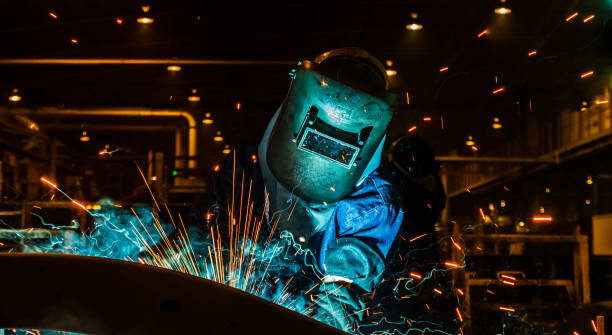
Looking for expert steel welding services in Sydney? Our professional welders specialize in high-quality fabrication, repairs, and custom metalwork. Whether you need MIG, TIG, or structural welding, B & R Australia Pty Ltd provides durable and precise solutions for residential, commercial, and industrial projects. With years of experience, state-of-the-art equipment, and a commitment to excellence, we ensure strong, reliable welds for all types of steel structures. Contact us today for top-tier welding services tailored to your needs!
Steel welding is a fundamental process in metal fabrication, involving the joining of steel components through the application of heat, pressure, or both, resulting in a solid and durable bond upon cooling. This technique is pivotal in constructing a wide array of structures and products, ranging from buildings and bridges to pipelines and machinery.
Types of Steel and Their Weldability
The weldability of steel varies based on its carbon content and alloying elements
-
Low-Carbon Steels (Mild Steel): Containing approximately 0.05% to 0.30% carbon, these steels are highly weldable and are commonly used in construction and automotive industries.Medium-Carbon Steels: With carbon content between 0.30% and 0.60%, these steels offer greater strength but require preheating and controlled cooling during welding to prevent cracking.
-
High-Carbon Steels: Containing 0.60% to 1.00% carbon, these steels are more prone to brittleness and necessitate careful welding procedures, including preheating and post-weld heat treatment.
-
Alloy Steels: Incorporating elements like chromium, nickel, and molybdenum, alloy steels possess enhanced properties but may require specific welding techniques to address challenges such as increased hardness and reduced ductility.
Common Steel Welding Processes
Several welding methods are employed based on the application’s requirements:
-
Shielded Metal Arc Welding (SMAW): Also known as stick welding, this versatile method uses a consumable electrode coated in flux to lay the weld.
-
Gas Metal Arc Welding (GMAW/MIG): Utilises a continuous wire feed as an electrode and an inert gas to shield the weld pool from contaminants.
-
Gas Tungsten Arc Welding (GTAW/TIG): Employs a non-consumable tungsten electrode with an inert gas shield, offering high-quality, precise welds suitable for thin materials.
-
Flux-Cored Arc Welding (FCAW): Similar to MIG welding but uses a special tubular wire filled with flux; it can be used with or without shielding gas.
Factors Influencing Weld Quality
Achieving a high-quality weld in steel involves several critical factors:
-
Preparation: Proper cleaning of the steel surfaces to remove rust, oil, and other contaminants ensures better weld integrity.
-
Heat Input: Controlling the amount of heat applied affects the microstructure of the weld and the heat-affected zone (HAZ), influencing strength and toughness.
-
Cooling Rate: Managing the cooling rate is essential to prevent the formation of undesirable microstructures like martensite, which can lead to brittleness.
-
Filler Material Selection: Choosing appropriate filler materials compatible with the base metal’s composition and mechanical properties is crucial for weld strength.
Challenges in Steel Welding
Welding steel presents specific challenges that require attention
-
Distortion and Residual Stresses: Uneven heating and cooling can cause warping and residual stresses, necessitating techniques like preheating, controlled welding sequences, and post-weld heat treatments to mitigate these effects.
-
Hydrogen Embrittlement: The absorption of hydrogen can lead to cracking; using low-hydrogen electrodes and ensuring dry welding conditions help prevent this issue.
-
Welding Dissimilar Steels: Joining different types of steel requires careful selection of filler materials and welding parameters to accommodate varying thermal and mechanical properties.
Advancements in Steel Welding
The field of steel welding continues to evolve with technological advancements:
-
Automation and Robotics: The integration of automated systems and robotics has enhanced precision, efficiency, and repeatability in welding operations.
-
Advanced Welding Techniques:Methods such as laser beam welding and friction stir welding offer improved control and are expanding the possibilities for welding complex steel structures.
-
Enhanced Filler Materials: Development of new filler materials with better mechanical properties and corrosion resistance contributes to stronger and more durable welds.
In summary, steel welding is a complex yet essential process in metal fabrication, requiring a thorough understanding of material properties, welding techniques, and quality control measures to produce strong, reliable, and safe welded structures.